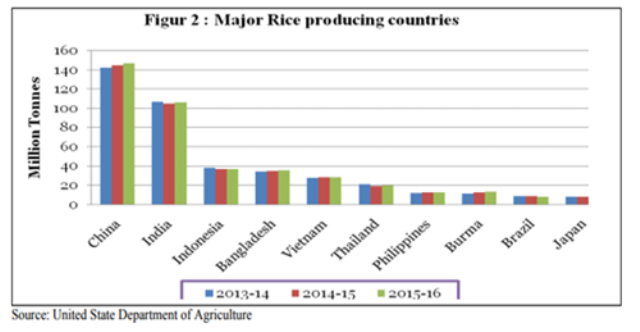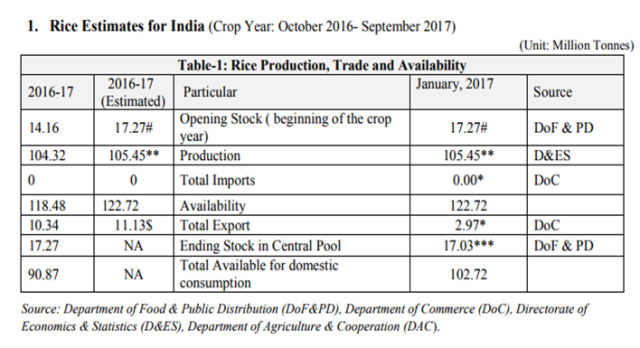
Rice is a staple crop which is consumed extensively throughout the country and the world indeed. But this global staple, comes with high environmental price and there has to be transformations in the global rice sector to meet the future demands alongwith enhancing farmer livelihoods in a sustainable way. Rice is a thirsty crop, which accounts 30-40% of the world’s irrigation water. The intensity of need of water can be understood by the fact that 3,000-5,000 litres of water is needed to produce 1kg of polished rice. Rice also accounts for approximately 13 percent of global nitrogen fertilizer use. Rice is critical to global food security and to the welfare of around 800 million impoverished people around the world.
Meeting the world’s future food and nutritional needs in a sustainable way presents critical development challenges, underscoring the urgent need for action to enhance production while minimizing the environmental footprint of rice systems and their vulnerability to climate change.
Low carbon rice and sustained incomes for rice farmers in developing countries were at the core of discussions at the first Global Sustainable Rice Conference and Exhibition in Bangkok. Thirty countries with 300 delegates gathered in the 2-day meeting to discuss the challenges facing the global rice sector, and to propose innovative collaborative approaches to enhance sustainability in the sector.
As a multi-stakeholder initiative with 80 institutional members, the Sustainable Rice Platform, co-convened by UN Environment and the International Rice Research Institute, partners the opportunity to participate in the transformative process and make a real contribution to the UN Sustainable Development Goals.
The Sustainable Rice Platform is a multi-stakeholder partnership to promote resource efficiency and sustainability, both on-farm and throughout rice value chains. The alliance works with over 80 institutional partners in the public and private sectors as well as international organizations, NGOs and the international research community to promote climate-smart best practice among rice smallholders in developing countries. In 2015 the world’s first Standard for Sustainable Rice Cultivation was launched, together with a set of Performance Indicators to enable monitoring of progress and impact. The launch triggered commitments by a number of private sector actors to achieve 100% sustainable sourcing within their global corporate supply chains by 2020. Revision of the Standard recently began with a 60-day online public consultation.
The Food and Agriculture Organization of the United Nations seeks to work with partners who strive to ensure the sustainability of rice production in ways that allow farmers to earn more income but that do not result in damage to ecosystems and the rice-based landscapes of the region.
Asia fills the world’s rice bowls and will continue to do so in the years to come. But such a major crop needs constant attention – by input suppliers, farmers, traders and the authorities whose policies govern its production. Aside from its extreme vulnerability to climate change impacts, rice production is itself a major contributor to climate change. According to the International Panel on Climate Change, rice fields contribute approximately 9-11 percent of the world’s non-CO2 agricultural emissions. Dr Kundhavi Kadiresan, Assistant Director-General and Regional Representative for Asia and the Pacific, Food and Agriculture Organization of the United Nations, emphasized in her keynote address in the global conference.
The Rice Production Countries are as given below:

Rice can be cultivated by different methods based on the type of region. But in India, the traditional methods are still in use for harvesting rice. The fields are initially ploughed and then fertilizer is applied which typically consists of cow dung and then the field is smoothed. The seeds are transplanted by hand and then through proper irrigation, the seeds are cultivated. Rice grows on a variety of soils like silts, loams and gravels. It can also tolerate alkaline as well as acid soils. However, clayey loam is well suited to the raising of this crop. Actually the clayey soil can be easily converted into mud in which rice seedlings can be transplanted easily. Proper care has to be taken as this crop thrives if the soil remains wet and is under water during its growing years. Rice fields should be level and should have low mud walls for retaining water. In the plain areas, excess rainwater is allowed to inundate the rice fields and flow slowly. Rice raised in the well watered lowland areas is known as lowland or wet rice. In the hilly areas, slopes are cut into terraces for the cultivation of rice. Thus, the rice grown in the hilly areas is known as dry or upland rice. Interestingly, per hectare yield of upland rice is comparatively less than that of the wet rice.
Rice is one of the chief grains of India. Moreover, this country has the largest area under rice cultivation, as it is one of the principal food crops. It is in fact the dominant crop of the country.India is one of the leading producers of this crop. Rice is the basic food crop and being a tropical plant, it flourishes comfortably in hot and humid climate. Rice is mainly grown in rain fed areas that receive heavy annual rainfall. That is why it is fundamentally a kharif crop in India. It demands temperature of around 25 degree Celsius and above and rainfall of more than 100 cm. Rice is also grown through irrigation in those areas that receives comparatively less rainfall. Rice is the staple food of eastern and southern parts of India. In 2009-10, total rice production in India amounted to 89.13 million tonnes, which was much less than production of previous year, 99.18 million tonnes. The Rice Production Estimate upto September 2017 is given below:

These concerns underscore the need for action to enhance resource efficiency and reduce the environmental and carbon footprint of rice systems. Ensuring economic, environmental and social sustainability on the farm and throughout rice value chains presents critical development challenges.
Summarizing these challenges in his opening address to the conference, Dr Matthew Morell, Director General of the International Rice Research Institute (IRRI), reminded delegates of the efforts of the international research community to develop innovative climate-smart best practice packages for rice smallholders.
The International Rice Research Institute and its national partners and collaborating institutions have developed proven technologies and approaches to help smallholders in developing countries produce rice more efficiently, more reliably, using less water and farm chemicals, while reducing greenhouse gas emissions and protecting the environment. We are proud to work as co-founders of the Sustainable Rice Platform to promote adoption of these climate-smart best practice packages by Asia’s farmers.









